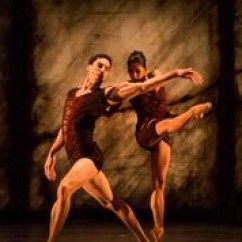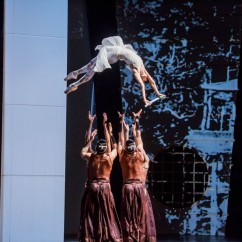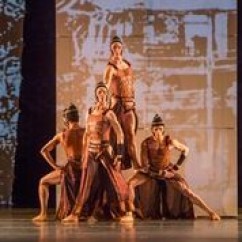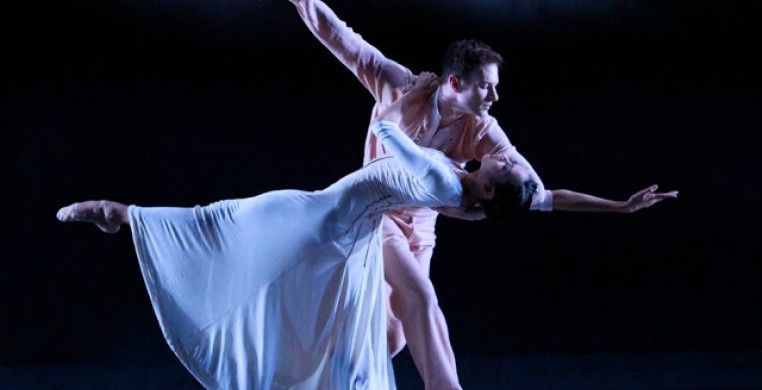Both poetry and dissonance defined Joffrey Ballet’s spectacular “Bold Moves” winter season (Auditorium Theater, through February 21), with distinctive music central to each of the three contemporary works on the program. Even before the curtain rose, the magical sound of the Chicago Philharmonic orchestra tuning up cued excitement to come. Live music, shaped by the sensitivity of musical director Scott Speck, brought the dancers’ charged moves to exquisite focus in all three pieces.  Anastacia Holden in "Forgotten Land"
Anastacia Holden in "Forgotten Land"
The program opened with Jiří Kylián’s “Forgotten Land” (1981), last performed by the Joffrey in 2012. A poetic revery set to Benjamin Britten’s darkly dramatic “Sinfonia Da Requiem,” “Forgotten Land” was inspired by Edvard Munch’s painting, “Dance Of Life” (1899) depicting a woman at the sea at different stages of her life. The choreography, structured around three duets, creates a sense of time past and the evolution of an individual’s emotional capacity for relationship. John F. Macfarlane’s dream-like abstraction of a seascape set the backdrop for a line of twelve dancers spanning across the stage, their backs to the audience as they made a slow progression toward the sea. A recurring movement theme interrupted their progression with a high arch of the spine, a dip and a swirl, bourées with feet wide apart, and bounding sideways sissones. Kylián’s own personal blend of ballet and classic modern dance mirrored the rhythmic and melodic conventions of Britten’s mid-20th-century music. The women, dancing in soft slippers, wore Grahamesque torso-hugging dresses that flared into ankle-length skirts, while the men wore simple full-sleeved shirts and slacks. Movement and music were as one in the three male-female duets, each reflecting a different emotional tone. Color-coding that corresponds to Munch’s painting gave us the fiery girl in red (Anastacia Holden) with her arduous suitor (Yoshihisa Arai) in sharp sudden gestures, quick jerky falls, and alternating playful and agitated interaction corresponding to the interplay of percussion and winds in the music. A sensual Christine Rocas was the woman in white with Rory Hohenstein pressing a hand across her abdomen, her torso contracting at his touch.
Dissonance and striking visual design distinguished British choreographer Ashley Page’s Joffrey-commissioned “Tipping Point,” receiving its world premiere Wednesday night. Alexander V. Nichols’ lighting geometrics dramatically defined both space and relationships, intriguing in the first half of the piece. A triangle of light isolated Edson Barbosa and Alberto Velasquez in a muscular duet, opening the piece to a soundscape of ominous drum rhythms. Two male-female couples anchored the movement design, with two trios and the men’s duet complimenting the couples in a perpetual motion landscape set to Thomas Adès’ challenging Violin Concerto. Christine Rocas, substituting for the injured April Daly, partnered brilliantly with Fabrice Calmels. Here, Page tapped into Calmels’ range of physical dynamics, a quality we don’t always get to see in this gifted artist. Victoria Jaiani and Dylan Gutierrez were stunning in a rhythmically complex balancing act. The intricacy of the movement’s spatial design echoed the clashing fury of strings in the music, at times creating choreographic rendering of the orchestration, at times a parallel thread independent of the music. The Joffrey dancers outshone themselves in this technically demanding piece, but movement vocabulary, for all its complexity, was relatively tame and left one craving more daring forays into the realm of heightened imbalance the title “Tipping Point” promises. Fabrice Calmels and Christine Rocas i n "Tipping Point"
Fabrice Calmels and Christine Rocas i n "Tipping Point"
Yuri Possokhov’s RAkU (2011) took us by storm in its 2014 Joffrey premiere and makes a welcome return this season for a much-warranted second viewing. Live performance of Shinji Eshima’s commissioned score renders the stage an absolutely shimmering spectacle of sublime dance theatre. All elements coalesce to create a totality of storytelling that restores faith for the story ballet’s comeback in contemporary dance. Alexander V. Nichols‘ magnificent scenery and projections form a mutable landscape of interiors and exteriors, palace, temple, and public arena, with the textures of cherry blossoms, falling snow, or raging fire. Mark Zappone’s gorgeous costumes are both functional as character-specific externalizations and evocative of the long ago and far away of mythic Japan. Possokhov’s choreography gets to the heart of each character’s internal need and dramatic action with movement invention that integrates folk forms, martial arts, and classical ballet with the spontaneity and emotional richness of impulse-driven modern dance.  Victoria Jaiani in "RAkU"
Victoria Jaiani, breathtakingly, heartbreakingly poignant as the Princess, takes us on the full journey of a soul, from love to loss. Temur Suluashvili’s bone-chilling malignancy as the Monk, and Fabrice Calmels‘ devoted and honorable Samurai polarize the stage as perfect opposites. The four Warriors--Edson Barbosa, Fernando Duarte, Stefan Goncalvez, and Graham Maverick--form a central quartet with impressive, highly-stylized ensemble work that forms the central image of a ceremonial culture, the time, and the place. Eshima’s score, textured with a cornucopia of percussion, sensual violins, and sonorous cellos conveys both rich melody and clear story without actually using any traditional Japanese folk instruments. An extra bonus is the live chanting by Ancient Dragon Zen Gate, Chicago Buddhist Student Association. Wrap it all in Nichols’ lighting and the Chicago Philharmonic’s fabulous music-making and you have a recipe full of wonder whose wholeness transcends itself. And wonderful it was!
Victoria Jaiani in "RAkU"
Victoria Jaiani, breathtakingly, heartbreakingly poignant as the Princess, takes us on the full journey of a soul, from love to loss. Temur Suluashvili’s bone-chilling malignancy as the Monk, and Fabrice Calmels‘ devoted and honorable Samurai polarize the stage as perfect opposites. The four Warriors--Edson Barbosa, Fernando Duarte, Stefan Goncalvez, and Graham Maverick--form a central quartet with impressive, highly-stylized ensemble work that forms the central image of a ceremonial culture, the time, and the place. Eshima’s score, textured with a cornucopia of percussion, sensual violins, and sonorous cellos conveys both rich melody and clear story without actually using any traditional Japanese folk instruments. An extra bonus is the live chanting by Ancient Dragon Zen Gate, Chicago Buddhist Student Association. Wrap it all in Nichols’ lighting and the Chicago Philharmonic’s fabulous music-making and you have a recipe full of wonder whose wholeness transcends itself. And wonderful it was! Warriors in "RAkU"
Warriors in "RAkU"

